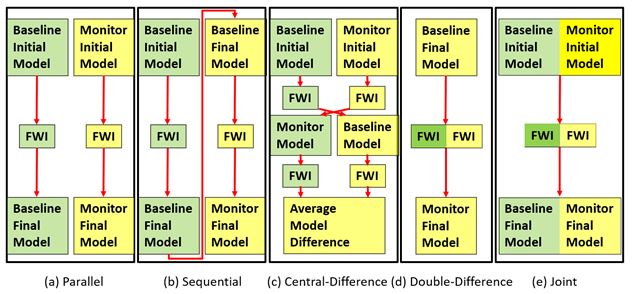This is an in-person event
Meeting Location:
TGS
10451 Clay Rd.
Houston, TX 77041
NOTE: You Must Be Logged In to Register
Check-In and Lunch begins at 11:30 am
Meeting presentation will be from 12:00 noon to 1:00 pm
Speaker: Weizhong Wang, GeoTomo LLC
Time-lapse studies of seismic data are often to detect subtle seismic waveform differences between baseline and monitor surveys (Lumley, 2001). These differences are typically caused by the changes in localized areas, such as gas or fluid volumes in conventional reservoirs, or stimulated reservoir volumes (SRV) in unconventional hydraulic fracturing. To identify these changes in the elastic properties, full-waveform inversion (FWI) is obvious an interest of the studies because of its capability to produce a high resolution velocity model (Bian et al., 2017; Kotsi and Malclm, 2017; Maharramov et al., 2016; Peng et al., 2018; Tarantola, 1984; Watanabe et al., 2004; Zhang and Huang, 2013). There are five FWI schemes in time-lapse studies: a) parallel, b) sequential, c) central-difference, d) double-difference, and e) joint inversion workflows. These methods are illustrated in Figure 1.

Fig. 1. Time-lapse FWI schemes: a) parallel, b) sequential, c) central-difference, d) double-difference, and e) joint inversion methods.
The parallel workflow (Fig. 1a) is equivalent to run FWI separately for each survey, presumably the starting model and all the parameters of each FWI are the same. The sequential workflow (Fig. 1b) is similar like the parallel workflow except the monitor FWI takes the final FWI model of the baseline survey as a starting model. As the inversion is performed independently, these methods do not require the acquisition geometries to be the same. Bearing the pain of non-uniqueness of FWI solutions, they require a significant amount of manual interpretation and quality control. The joint inversion (Fig. 1e) (Maharramov et al., 2016) can penalize the model difference to stabilize the FWI regularization. We feel it is difficult to isolate the 4D changes to be only around the reservoirs. Zhou and Lumley (2019) proposed a central-difference method (Fig. 1c). We perform time-lapse FWI using the double-difference workflow (Fig. 1d) (Bian et al., 2017; Watanabe et al., 2004; Zhang and Huang, 2013), where we can mask the monitor model to be only different from the baseline at the reservoirs. The starting model of the double-difference FWI is the final model of the baselines FWI, and the input data of this workflow is the waveform difference between the monitor and baseline surveys. The waveform difference generated by the elastic property changes between time-lapse surveys can be regarded as the scatter waves. Even though the starting model, which is the baseline model in this scheme, may have its own error, the scatter waves can be migrated to isolated areas around the reservoirs, rather than to distribute the energy to the whole area. Real and synthetic data examples will be demonstrated in the talk.
Speaker Biography: Weizhong Wang, GeoTomo
Weizhong Wang received his Ph.D. in Automation from Tsinghua University, China in 1989. After graduation, he joined the Geophysical Lab at the University of Toronto as a postdoctoral fellow, working on Canada’s national research project LITHOPROBE. In 1993, he was employed at Veritas Seismic in Calgary as a research geophysicist, then GeoCenter, and PGS before joining GeoTomo in 2005. He currently is the vice president of GeoTomo, leading the efforts in technology development at GeoTomo LLC.
** Access information will be sent to all registrants after registration closes.
Price List:
|
Pre-Registered |
Late/Walk-Up
|
Member
|
Free |
Free |
| Non-Member |
$10 |
$10 |
** Please be aware that ALL registrations must go through 'Checkout', even if your total is zero. Registration is not confirmed until you complete the checkout process.
THANK YOU TO OUR SPONSOR:
